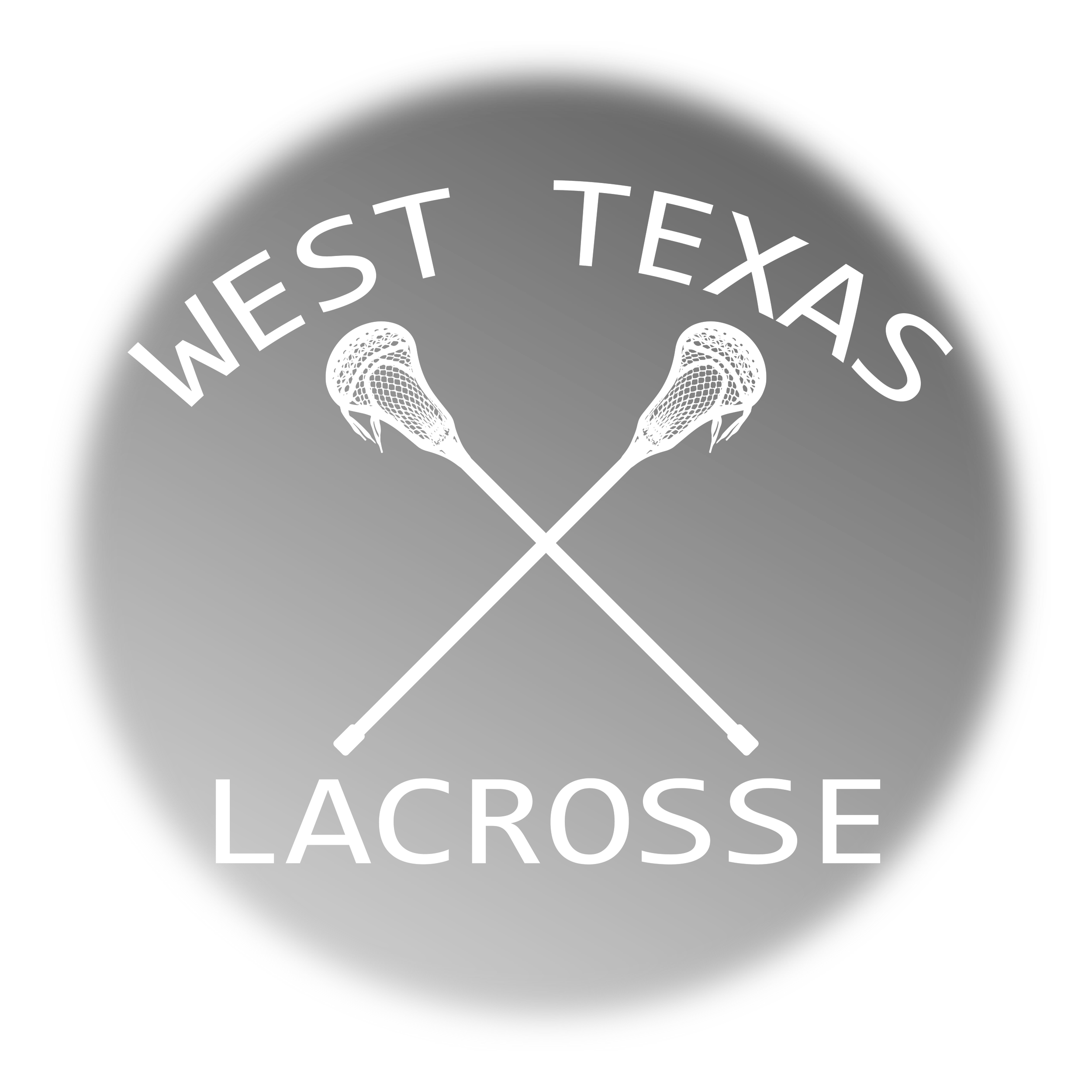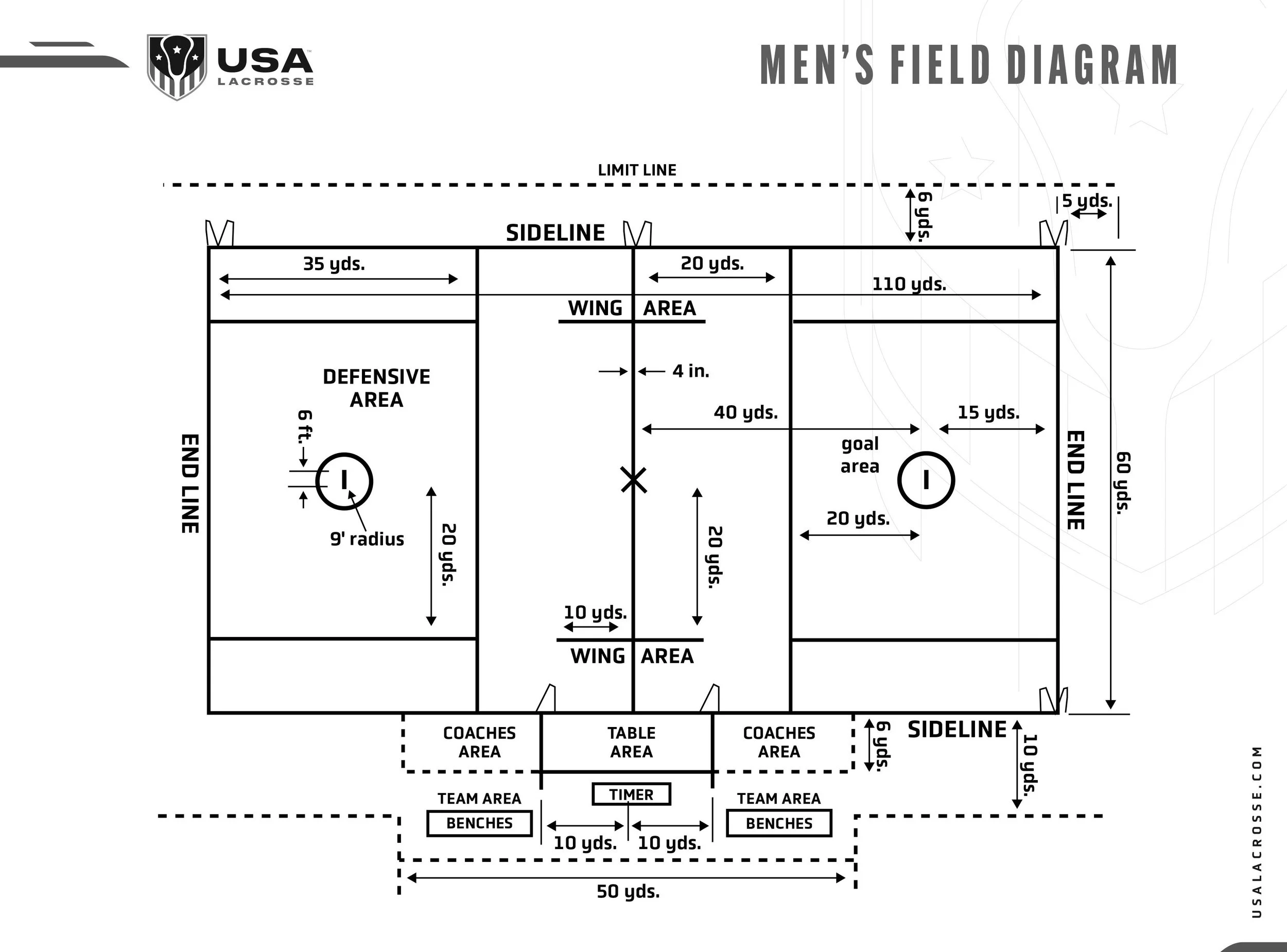Boys' lacrosse is a contact game played by ten players: a goalie, three defensemen, three midfielders and three attackmen. The object of the game is to shoot the ball into the opponent's goal and to keep the other team from scoring. The team scoring the most goals wins.
Player Positions:
Attack: The attackman’s responsibility is to score goals and assist in scoring by passing the ball. The attackman generally restricts his play to the offensive end of the field (opponent’s end).
Midfield (aka “Middies”): The midfielder’s responsibility is to cover the entire field, playing both offense and defense. The midfielder is a key to the transition game, and is often called upon to clear the ball from defense to offense.
Defense: The defenseman’s responsibility is to defend the goal. The defenseman generally restricts his play to the defensive end of the field. Each team has three defensemen on the field.
Goalie: The goalie’s responsibility is to protect the goal and stop the opposing team from scoring.
GAMEPLAY:
High school games are usually 48 minutes long, with 12-minute quarters. Teams change sides between periods. Each team is permitted two timeouts each half. The team winning the coin toss chooses the end of the field it wants to defend first.
Play begins with a face-off at midfield. To begin the game, the players take their positions on the field: four in the defensive clearing area, one at the center, two in the wing areas and three in their attack goal area. Each face-off player tries to control the ball. The players in the wing areas can run after the ball when the whistle sounds. The other players must wait until one player has gained possession of the ball, or the ball has crossed a goal area line, before they can release. Face-off’s will also occur after each goal and to begin each new period of play.
Both teams must keep at least four players, including the goalie, in its defensive half of the field and three in its offensive half. Three players (midfielders) may roam the entire field.
Only the goalkeeper may touch the ball with his hands, and only the goalie or a defensive player may enter the crease (the 9-foot circle around the teams goal). A player may gain possession of the ball by dislodging it from an opponent's crosse with a stick check. A stick check is the controlled poking and slapping of the stick and gloved hands of the player in possession of the ball.
Body checking is permitted if the opponent has the ball or is within five yards of a loose ball. All body contact must occur from the front or side, above the waist and below the shoulders, and with both hands on the stick. An opponent's crosse may also be stick checked if it is within five yards of a loose ball or ball in the air. Aggressive body checking is discouraged.
If the ball or a player in possession of the ball goes out of bounds, the other team is awarded possession. If the ball goes out of bounds after an unsuccessful shot on goal (i.e. a missed scoring attempt that passes through the crease), the player nearest to the ball when and where it goes out of bounds is awarded possession. Players typically sprint after the ball on a missed shot, hoping to be the closest player to the ball when it goes out of bounds.
An attacking player cannot enter the crease around the goal, but may reach in with his stick to scoop a loose ball.
A referee, umpire and field judge supervise field play. There are personal fouls and technical fouls in boys' lacrosse. The penalty for a personal foul generally results in a one-to-three minute suspension from play and possession to the team that was fouled. Players with five personal fouls are ejected from the game. The penalty for a technical foul is a 30-second suspension if a team is in possession of the ball when the foul is committed, or possession of the ball to the team that was fouled if there was no possession when the foul was committed. Generally, the official will throw a flag to signify that a foul has occurred, but play may not immediately stop; play will continue until a turnover happens if the ball is possessed by the team that was fouled (aka the “Play On” rule).
Personal Fouls:
Slashing: Occurs when a player’ s stick contacts an opponent in any area other than the stick or gloved hand on the stick.
Tripping: Occurs when a player obstructs his opponent at or below the waist with the crosse, hands, arms, feet or legs.
Cross Checking: Occurs when a player uses the handle of his crosse between his hands to make contact with an opponent.
Unsportsmanlike Conduct: Occurs when any player or coach commits an act which is considered unsportsmanlike by an official, including taunting, arguing, or obscene language or gestures.
Unnecessary Roughness: Occurs when a player strikes an opponent with his stick or body using excessive or violent force.
Illegal Body Checking: Occurs when any of the following actions takes place:
A. body checking an opponent who is not in possession of the ball or within five yards of a loose ball;
B. avoidable body check of an opponent after he has passed or shot the ball;
C. body checking an opponent from the rear or at or below the waist;
D. body checking an opponent above the shoulders. A body check must be below the shoulders and above the waist, and both hands of the player applying the body check must remain contact with his crosse.
Illegal Crosse: Occurs when a player uses a crosse that does not conform to required specifications. A crosse may be found illegal if the pocket is too deep or if any other part of the crosse was altered to gain an advantage.
Illegal Gloves: Occurs when a player uses gloves that do not conform to required specifications. A glove will be found illegal if the fingers and palms are cut out of the gloves, or if the glove has been altered in a way that compromises its protective features.
Technical Fouls :
Crease Violation: Occurs when an offensive player deliberately, through his own momentum, enters the opponent1 s goalcrease or a defensive player, including the goalkeeper, with the ball in his possession, enters from the surrounding playing field into his own goalcrease.
Holding: Illegally impedes the movement of an opponent with the ball.
Illegal Offensive Screening: Occurs when an offensive player, through moving contact of his body or equipment, blocks a defensive player from the man he is playing, or impedes his normal movements of playing defense.
Interference: Occurs when a player interferes in any manner with the free movement of an opponent, except when that opponent has possession of the ball, the ball is in flight and within five yards of the player, or both players are within five yards of a loose ball.
Offsides: Occurs when a team does not have at least four players on its defensive side of the midfield line or at least three players on its offensive side of the midfield line.
Pushing: Occurs when a player thrusts or shoves a player from behind.
Stalling: Occurs when a team intentionally holds the ball, without conducting normal offensive play, with the intent of running time off the clock.
Warding Off: Occurs when a player in possession of the ball uses his free hand or arm to hold, push or control the direction of an opponent’s stick check.
Withholding The Ball From Play: Occurs when a player clamps a loose ball against the ground more than momentarily or clamps the ball against his body to prevent it from being dislodged.
COMMON TERMS:
Attack Goal Area: The area around the goal defined by the endline, the Goal Area Line and the two broken lines located 20 yards on either side of the goal. Once the offensive team crosses the midfield line, it has 10 seconds to move the ball into its attack goal area.
Body Check: Contact with an opponent from the front - between the shoulders and waist - when the opponent has the ball or is within five yards of a loose ball. At no time should a player initiate or receive body contact with his head.
Box: An area between the two team benches used to hold players who have been served with penalties, and through which substitutions "on the fly" are permitted directly from the sideline onto the field.
Check-Up: A call given by the goalie to tell each defender to find his man and call out his number.
Clamp: A face-off maneuver executed by quickly pushing the back of the stick on top of the ball.
Clearing: Running or passing the ball from the defensive half of the field to the offensive half of the field.
Crease: A circle around the goal with a radius of nine feet into which only defensive players may enter. Defensive players may not take the ball into the crease.
Crosse (stick): The equipment used to throw, catch and carry the ball.
Defensive Clearing Area: The area defined by a line drawn sideline to sideline 20 yards from the face of the goal. Once the defensive team gains possession of the ball in this area, it has 10 seconds to move the ball beyond the Goal Area Line. Once beyond the Goal Area Line, the defensive team may not pass or run the ball back into the Defensive Clearing Area.
Face-off: A technique used to put the ball in play at the start of each quarter, or after a goal is scored. The players squat down and the ball is placed between their crosses.
Fast-Break: A transition scoring opportunity in which the offense has at least a one-man advantage.
Ground Ball: A loose ball on the playing field.
Midfield Line: The line which bisects the field of play.
On-The-Fly Substitution: A substitution made during play.
Pick: An offensive maneuver in which a stationary player attempts to block the path of a defender guarding another offensive player.
Play On: If a player commits a loose-ball technical foul or crease violation and an offended player may be disadvantaged by the immediate suspension of play, the official shall visually and verbally signal “play on” and withhold the whistle until such time as the situation of advantage, gained or lost, has been completed.
Release: The term used by an official to notify a penalized player in the box that he may re-enter the game occurs at the conclusion at a time-serving penalty.


